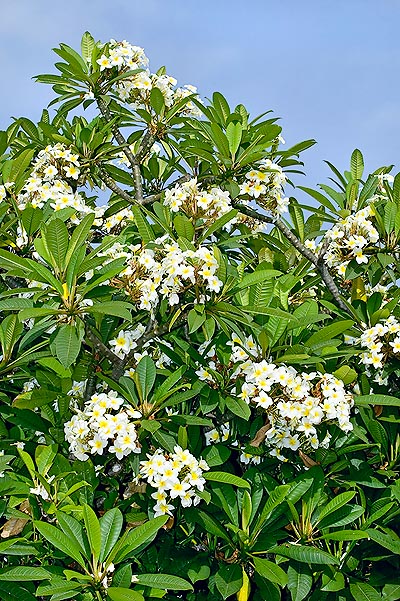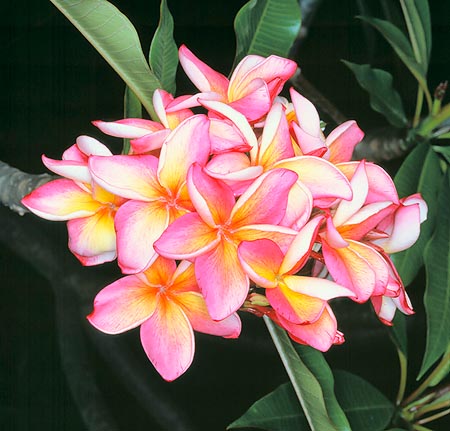Family : Apocynaceae

Text © Pietro Puccio

English translation by Mario Beltramini

Plumeria rubra © Giuseppe Mazza
The Plumeria rubra L. (1753) is native to Americas, from Mexico to Venezuela (Mexico, Belize, Costa Rica, El Salvador, Guatemala, Honduras, Nicaragua, Venezuela).
The genus is honoured to the French missionary Charles Plumier (1646-1704), who collected and studied a huge number of plants of the Caribbean area by the end of 1600; the name of the species is the Latin word “rubra” = red, with obvious signification.
Common names : “pomélia” (particularly in Palermo), “frangipane”, “frangipani” (Italian); “temple tree”, “templetreee”, “nosegay”, “pagoda tree”, “frangipani tree”, “red paucipan”, “red-jasmine” (English); “tipanier” (particularly in Haiti), “frangipanier”, “fleur des temples” (French); “flor de mayo”, “flor de la Cruz”, “flor de leche”, “amapola”, “frangipán rojo”, “grangipanes”, “alhelí”, “alhelí cimarrón” (Spanish); “Pagodenbaum”, “Tempelbaum”, “Jasminbaum”, “Frangipani” (German); “flor-de-Santo-Antônio”, “jasmim-de-caiena”, “jasmim-do-para”, “jasmin-do-para”, “jasmin-manga” (Portuguese).
Deciduous or semi-deciduous plant, it appears as a shrub or as a tree of small or medium size, with broad foliage, which can reach about 8 metres of height; it has a fleshy stalk, corky with the age, and oblong leaves up to about 50 cm of length. Terminal inflorescences with showy flowers, bisexual, funnel-shaped, with a diameter of 7-12 cm, intensely perfumed, with 5 (seldom 6-7) fleshy petals, which can be of white colour with yellow centre, fully yellow or in several tones of pink, red and purple. The fruits are fusiform coupled follicles, 15-25 cm long, containing several flat seeds provided with a membranous wing, suitable for allowing their dispersal. It easily and usually reproduces by cutting and air layering.
Plant of very great ornamental value, due to the beauty and the perfume of its flowers, it has become one of the symbols of the tropics, spreading, already since the 1500, first to south east Asia and then in the other tropical and subtropical zones.
The cultivation can be tried, in full sun and in draining soils, also in particularly mild areas of the temperate-warm zones, like the coasts of Sicily, elsewhere it must be cultivated in pot, in order to be sheltered in winter, as it does not bear temperatures around the zero, or little less, especially if in conjunction with high humidity of the milieu and of the soil. Favoured in this by the fact that the areas from which it comes are characterized by two distinct seasons, a dry and rather cool one, roughly corresponding to our winter, during which it goes in vegetative stasis, and the other, warm-humid and rainy, from May to October, during which it is vegetating.
Thus, in winter, it can be left in an airy and dry space, without, practically, any need of attentions, and then in spring, it is to be placed again in the open, better if exposed to the south, as it needs at least 6-8 hours of sun per day for giving a good blooming.

The flowers can be white with yellow centre, yellow, pink and red © Mazza
Synonyms: Plumeria incarnata Mill. (1768); Plumeria arborea Noronha, (1790); Plumeria bicolor Ruiz & Pav. (1799); Plumeria carinata Ruiz & Pav. (1799); Plumeria lutea Ruiz & Pav. (1799); Plumeria purpurea Ruiz & Pav. (1799); Plumeria tricolor Ruiz & Pav. (1799); Plumeria acuminata (1811); Plumeria acutifolia Poir. in J.B.A.P.M.de Lamarck (1812); Plumeria mollis Kunth in F.W.H.von Humboldt, A.J.A.Bonpland & C.S.Kunth (1819); Plumeria mexicana Lodd. (1825); Plumeria conspicua G.Don in J.C.Loudon (1830); Plumeria lambertiana Lindl. (1830); Plumeria kunthiana Kostel. (1834); Plumeria arborescens G.Don (1837); Plumeria aurantia Lodd. ex G.Don (1837); Plumeria blandfordiana Lodd. ex G.Don (1837); Plumeria gouanii D.Don ex G.Don. (1837); Plumeria kerrii G.Don (1837); Plumeria macrophylla Lodd. ex G.Don (1837); Plumeria milleri G.Don (1837); Plumeria northiana Lodd. ex G.Don (1837); Plumeria tenuifolia Lodd. ex G.Don (1837); Plumeria aurantiaca Steud. (1841); Plumeria angustifolia A.DC. in A.P.de Candolle (1844); Plumeria megaphylla A.DC. in A.P.de Candolle (1844); Plumeria aurantia Endl. in A.Hartinger (1846); Plumeria jamesonii Hook. (1853); Plumeria loranthifolia Müll.Arg. in C.F.P.von Martius & auct. suc. (1860); Plumeria rubra f. acuminata (W.T.Aiton) Woodson (1938); Plumeria rubra f. acutifolia (Poir.) Woodson (1938); Plumeria rubra f. lutea (Ruiz & Pav.) Wood (1938); Plumeria rubra f. tricolor (Ruiz & Pav.) Woodson, (1938); Plumeria rubra var. acuminata (W.T.Aiton) R.S.Rao & Balamani (1984).
→ To appreciate the biodiversity within the APOCYNACEAE family please click here.
